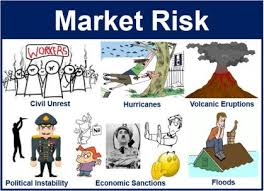
Introduction to Market Risks and Market Risk Types
 Market risk refers to the chance of an investor to incur losses because of factors that affect the overall performance of the financial markets. In this article, we’re going to discuss its meaning and its types, as well as the way to measure the risks explained.
Market risk refers to the chance of an investor to incur losses because of factors that affect the overall performance of the financial markets. In this article, we’re going to discuss its meaning and its types, as well as the way to measure the risks explained.
Defining Market Risk
Market risk and specific risk make up the two main categories of investment risk. The most common kinds of market risks include interest rate risk, currency risks, commodity risks, and equity risks.
Public companies in the United States follow requirements from the US Securities and Exchange Commission, including the disclosure of their productivity and results and how these are connected to the performance of the broader financial markets.
In contrast to market risk, specific or unsystematic risk is directly related to the performance of a specific security. You can protect yourself from unsystematic risk by diversification.
Main Types of Market Risks
There are generally four types of market risks you should be on the lookout for. Here they are.
Interest Rate Risk
Interest rate risk involves the volatility come with interest rate fluctuations that are caused by fundamental factors, including central bank announcements that have something to do with monetary policies. This kind of risk is closely watched among investors of fixed-income investments like bonds.
Equity Risk and Commodity Risks
Equity risk is the risk involved in the changing prices of stock investments while commodity risks include the changes in the prices of commodities like crude oil and gold.
Currency Risks
Currency or exchange-rate risk comes from the changes in the price of one currency in relation to another. Investors or companies that hold assets in another country are always subject to currency risks.
Volatility and Hedging
There is market risk because of the changes in prices. The standard deviation of the changes in stock prices, currencies, or commodities are usually called price volatility.
Volatility is measured in annualized terms and can be expressed as an absolute number like $10 or a percentage like 10 percent.
For investors, hedging strategies become useful to guard themselves from volatility and market risk. Targeting certain securities compel investors to buy put options to protect against a downside move. Investors who want to hedge a huge portfolio of stocks can use index options.
Measurements of Market Risks
In order to gauge market risks, investors and analysts use the value-at-risk (VaR) strategy. This model is a statistical risk management method that quantifies a stock or portfolio’s potential losses as well as the probability of a potential loss as well as the probability of incurring a loss.
Even if it is well-known and widely used among investors and analysts, the method requires specific assumptions that quite limit is efficiency.
For instance, the model assumes that the portfolio structure doesn’t remains the same over a specified time. This may work properly for short-term time horizon, but it may yield to less accurate measurements when it comes to the longer-term.
Beta is also a measure of risk since it measures the volatility or market risk of a security or portfolio in relation to the broader market. Further, the beta is used in the capital asset pricing model, or CAPM, to determine the expected return of an asset.


